Pachypodium (Pachypodium) is a genus of treelike plants of the Kutrov family. Such plants in nature can be found in the arid regions of Madagascar, Australia and Africa. This genus unites 23 species. From Greek "pachypodium" is translated as "thick leg" because the bush has a fleshy volumetric trunk covered with thorns. Under natural conditions, such a plant has a height of about 8 m, and its trunk reaches 1.5 m in diameter.However, when grown indoors, the height of the bush does not exceed 100 cm.
Content
- 1 Features of the pachypodium
- 2 Pachypodium care at home
- 3 Reproduction of the pachypodium
- 4 Pests and diseases of the pachypodium
- 5 Types and varieties of pachypodium with photos and names
- 5.1 Pachypodium lamerei, or Madagascar palm
- 5.2 Pachypodium geayi
- 5.3 Pachypodium short-stemmed (Pachypodium brevicaule)
- 5.4 Pachypodium saundersii
- 5.5 Pachypodium succulentum
- 5.6 Pachypodium densiflorum
- 5.7 Pachypodium horombense
- 5.8 Pachypodium meridionale
- 5.9 Pachypodium rosette (Pachypodium rosulatum)
- 5.10 Pachypodium rutenbergianum
Features of the pachypodium
The pachypodium is a succulent tree or shrub. With a large number of differences between varieties and species, such plants have such a characteristic feature as a thick trunk, in which a supply of liquid accumulates in case of drought. Outwardly, the species that make up this genus are very different from each other: from cactus-like trees to bottle-shaped dwarfs. Almost all species of such a plant have thorns, which are grouped in 2-3 pieces, they are placed around the trunk in rings or spirally. Only a part of the species of this genus does not form branches, and the rest of the species are distinguished by rather strong branching. This genus differs from other representatives of the Kutrovy family in that such plants have transparent juice, not milky, but still it is poisonous. When grown at home, the height of the pachypodium varies from 0.3 to 1.5 m, while its lifespan is 3-15 years.
Pachypodium care at home
Illumination
The pachypodium needs a lot of light, and it must be taken into account that the direct rays of the sun do not harm it. In summer, it is recommended to move it to fresh air (to the garden or to the balcony), but it must be accustomed to the new conditions gradually.When choosing a suitable window for a room, it is recommended to prefer one that is located in the southwest, south or southeast part of the room. When spring comes after winter with its short daylight hours, the plant must also be gradually accustomed to direct sunlight.
Temperature regime
The bush responds well to frequent ventilation, as it loves fresh air, but it must be protected from drafts. In summer, the pachypodium does not differ in its exactingness to the air temperature; it can grow and develop normally at both 18 and 28 degrees. In winter, when he has a dormant period, he needs to be rearranged to a cool place (from 16 to 18 degrees).
How to water
When grown indoors, it is very easy to care for such a plant. In the spring-summer period, it should be watered moderately, while the soil mixture in the pot should be constantly slightly damp. When there is a lack of water, the foliage is observed flying around the bush, which makes it less attractive. If, on the contrary, there is too much water, then the bush will become painfully elongated, which also has an extremely negative effect on its decorative effect. Watering is carried out immediately after the substrate dries to a depth of 10 mm. When growing a short-stemmed pachypodium, it is poorly watered throughout the year. In the event that all the foliage falls off the bush, then it must be stopped completely watered, and after only about 1.5 months it will grow back. It should not be forgotten that such a culture is watered only with well-settled water.
Air humidity
This flower does not need high humidity. However, it is recommended to moisten it from time to time from a sprayer with well-settled water at room temperature, and before that, all its sheet plates must be wiped with a moistened soft cloth or sponge.
Top dressing
They begin to feed such a flower at the beginning of the spring period after the bush begins to grow new shoots, and they do this until mid-autumn. To do this, use a fertilizer solution for cacti, which must be applied once every 4 weeks to a previously watered substrate. For 4 weeks after transplanting, as well as when the bush is sick, no feeding is carried out. Before the plant enters a dormant period, it is completely stopped feeding. They begin to feed again only with the onset of the next spring period.
Pachypodium transplant
While the pachypodium is young, it needs an annual transplant into a larger container, and this procedure is carried out in the spring. Adult specimens are transplanted much less often, as a rule, once every 3 or 4 years. A moderately acidic soil mixture for cacti is best suited for growing such a flower. Such a substrate can be made with your own hands; for this, leaf and sod land are connected, as well as coarse-grained river sand (1: 1: 1). In order for the soil mixture to be well-drained, charcoal or brick chips should be added to it. Before planting in a new pot, you need to make a good drainage layer; for this, expanded clay is poured into it, which should fill the container by 1/3 part.
When transplanting, you need to be very careful, as you can easily injure the root system of the bush. If the flower is not sick with anything, then it just needs to be transferred to a new container, while the remaining empty space must be covered with a previously prepared substrate (see above). If the bush has a diseased root system, then first you need to carefully remove the remnants of the old soil mixture from it, then cut out all dried or rotten areas and sprinkle the wounds with crushed charcoal. And then the bush is planted in a new pot.
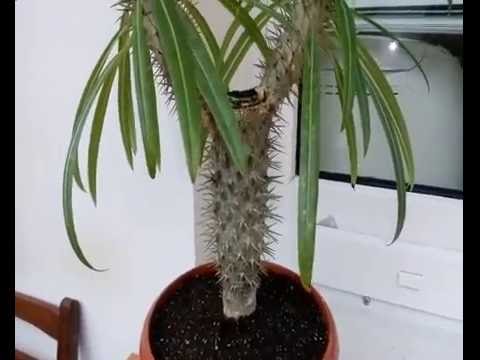

Watch this video on YouTube
Bloom
The pachypodium is a slow-growing plant, therefore it blooms for the first time only when it is 6 or 7 years old. However, if he is provided with the wrong or poor care, then flowering may never come at all.If you take proper care of the plant, protect it from drafts, feed and water it in time, choose the right place in the room, then you may be able to see the flowering of the pachypodium.
Virulence
The bush contains poisonous juice. If it gets on the mucous membranes, it will irritate them, and even this juice corrodes the wounds on the skin. In this regard, the area of the skin that has gotten the juice must be rinsed with plenty of running water.
Reproduction of the pachypodium
Growing from seeds
The pachypodium can be propagated by the seed (generative) method, but it should be borne in mind that it is rather difficult to get the seeds of such a plant in indoor conditions on your own. When sowing, seeds are buried into the substrate by 5 mm, from above the container must be covered with a film or glass. Then the crops are harvested in a well-lit cool (about 20 degrees) place. When the first seedlings appear, the shelter should be removed, but they do it gradually, accustoming the plant to new conditions. After the seedlings are strong, they should be dived into individual pots, and then they are provided with the same care as the adult bushes. Before deciding on this method of reproduction, it should be noted that the pachypodium grows from seeds very, very slowly.
Cuttings
This plant can be propagated by cuttings, but such cuttings very rarely root normally. However, there are cases when the top of a bush that has rotted at the base was cut off, and it successfully rooted. To do this, cut off the upper part at a height of 15 centimeters using a very sharp pre-sterilized tool, sprinkle the cut with crushed charcoal, and then plant the cutting in a soil mixture intended for planting an adult pachypodium (see above). Place the cutting in a well-lit area.
Pests and diseases of the pachypodium
Diseases
When grown indoors, the pachypodium is highly sensitive to too much moisture, and this is expressed in the appearance of a variety of rot. In order to protect the bush from fungal disease, it must be properly watered. It should also be borne in mind that such a succulent plant tolerates drought much easier, but stagnation of water in the substrate can cause rotting and thinning of the stem, as well as blackening and flying around the foliage. As soon as you notice that the bush has begun to rot, you must immediately suspend watering and remove it to a warm place. The plant and soil mixture in a pot must be sprayed with a solution of a fungicidal preparation, and in order to prevent relapses, it is imperative to revise the watering regime.
Harmful insects
If the air humidity in the room is too low, then spider mites can settle on the plant, which suck cell sap from the bush. It is almost impossible to see such a tick with the naked eye, but a sure sign that a bush is occupied by such a pest is the presence of a thin web on its surface. To get rid of this pest, the pachypodium must be thoroughly rinsed under a warm shower, and it is also recommended to increase the humidity in the room. To do this, every evening the plant must be moistened from a sprayer with well-settled lukewarm water. In the case when there are a lot of ticks on the bush, acaricides such as Aktellik, Fitoverm, Aktara or Akarin are used to destroy them.
If the room is relatively hot and the air humidity is low, then thrips can settle on the pachypodium. This pest also sucks the cell sap from the flower. In this case, light-colored dots and silvery stains are formed on the front surface of the leaf plates. In this case, the harmful insects themselves are on the seamy surface of the foliage. You can get rid of such a pest with the same drugs that are used in the fight against spider mites.
Types and varieties of pachypodium with photos and names
Pachypodium lamerei, or Madagascar palm
This species is a tree, the height of which can be up to 600 cm. Its trunk is thick and prickly. In adult specimens, the foliage at the top of the trunk is located in almost the same way as in a palm tree; it is with this feature that the second name of this species is associated. The thickened erect stem lignifies in the lower part, on its surface there are protruding tubercles, which are arranged in a spiral. Each such tubercle has 3 powerful spines. On the upper part of the stem, a rosette is formed, which consists of dark green petiolate leaf plates with an elongated-lanceolate shape, their length varying from 0.2 to 0.4 m. 3 naked spines grow under each leaf plate. White-cream or pale pink flowers have a yellow center, they reach about 11 centimeters in diameter. The green fruits are oval in shape. When grown indoors, the height of the bush does not exceed 50 cm.This species has several varieties:
- typica - the seamy surface of the leaf plates is pubescent;
- ramosum - a branched trunk is decorated with leaf plates with a pronounced central vein, umbrella-shaped inflorescences consist of white flowers, which reach about 10 centimeters in diameter.
Pachypodium geayi
The height of such a tree varies from 300 to 600 cm. Its trunk is thick and covered with thorns. While the plant is young, it is very similar to Lamer's pachypodium, but its foliage is narrower (width from 10 to 30 mm), and there is pubescence on its surface. The color of young spines is grayish, but the tips are painted black. White flowers have a yellow center. At home, the height of the bush does not exceed 0.5–0.6 m.
Pachypodium short-stemmed (Pachypodium brevicaule)
There is no foliage on the bush, it looks like gray stones that surround it in natural conditions. Tuberous flat stem, covered with thorns, reaches a height of about 0.6 m. During flowering, elongated yellow flowers open on the bush.
Pachypodium saundersii
The stem of such a succulent plant is greenish-gray, almost spherical, it reaches a height of about 150 cm. On the surface of the bush there are a small number of thorns, which reach 25 mm in length. The shape of the leaf plates is broadly lanceolate, while their apex is pointed. During flowering, a large number of white flowers grow on the bush, with a pink stripe on each petal.
Pachypodium succulentum
The bush has a turnip root, which gradually turns into a thickened tuber, reaching 15 centimeters in diameter. Above, the root becomes a stem, which lignifies over time, it is branched and branched, and its height varies from 0.6 to 0.9 m.There are paired spines on young branches, the length of which is from 10 to 20 mm, and a little pubescent leaf plates lanceolate, their length is about 50 mm, and their width is up to 10 mm. Flowering is observed in summer, at this time the bush is decorated with bell-shaped flowers of light pink color with a red throat, their diameter is about 40 mm.
Pachypodium densiflorum
Such a succulent shrub is characterized by slow growth, its height does not exceed 0.45 m.The fleshy trunk of a greenish-gray color is covered with thorns, it reaches 0.3 m in diameter.At the apex of the trunk there is a leaf rosette, consisting of leaves, the front surface of which is green , and the wrong side is gray-felt. Tubular rich yellow flowers reach 30 mm in diameter, they have a widened end, and the existing yellow anthers form a cone.
Pachypodium horombense
This not very tall plant has a smooth wide greenish-silvery trunk, which is thickened at the base. Narrow small leaf plates of greenish-gray color form rosettes on the tops of branches. Long pedicels have yellow flowers.
Pachypodium meridionale
In nature, such a plant reaches a height of 300 cm, but when grown at home, the bush cannot be higher than 120 cm.The narrow and long leaf plates are green in color. The smooth brownish-silvery trunk reaches about 0.6 m in diameter. The large flowers have a pleasant aroma, they consist of a pale red corolla and pink petals.
Pachypodium rosette (Pachypodium rosulatum)
Such a fleshy succulent plant has upright cylindrical branches and caudex. Greenish-gray short trunk thickened at the base. There are a large number of thorns on the surface of the branches. Leathery shiny green leaf plates of a narrowed-oblong shape have a light-colored central vein. Foliage grows at the tops of branches, and it is collected in rosettes or whorls. Small-flowered racemose inflorescences with long pedicels, consist of tubular flowers of yellow or yellow-green color.
This species has a variety - graceful (Pachypodium rosulatum var. Gracilius): the height of the bush is from 0.4 to 0.6 m with a caudex of brownish or gray color, it is round and slightly compressed from the sides, it can be smooth or there is a large number of thorns. The branches are short, meandering, they can be spiny or smooth. At the tops of the branches are leaf rosettes. The rich yellow flowers are grouped on long pedicels, they are tubular and have a widened end.
Pachypodium rutenbergianum
In nature, such a caudex plant reaches a height of 8 meters, but when grown at home, it does not exceed 0.6 meters. On the surface of the short branches, there are thorns, reaching about 10 mm in length. Dark green shiny leaf plates have an oblong shape and a light central vein. They are collected in sockets at the tops of the branches. The foliage is about 15 centimeters long and up to 4 centimeters wide. Terminal inflorescences consist of 3 or 4 large white flowers, which have a tube extended towards the end.


Watch this video on YouTube

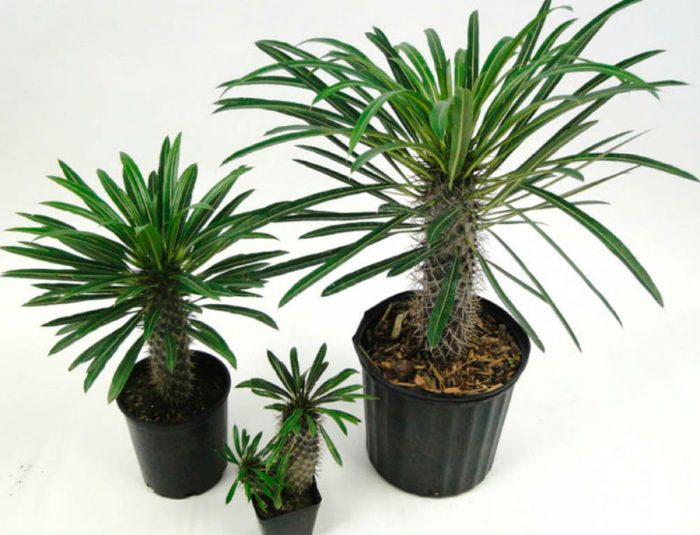
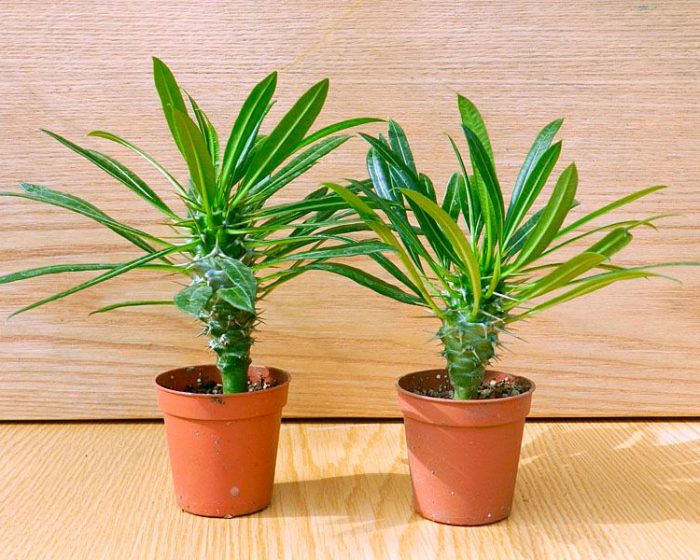
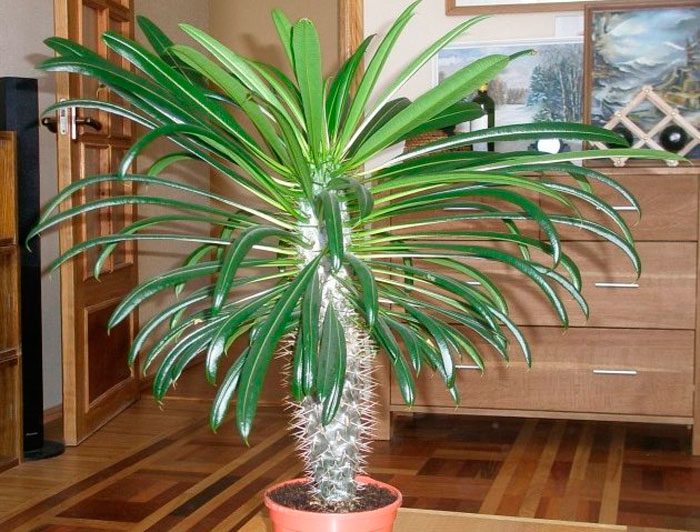
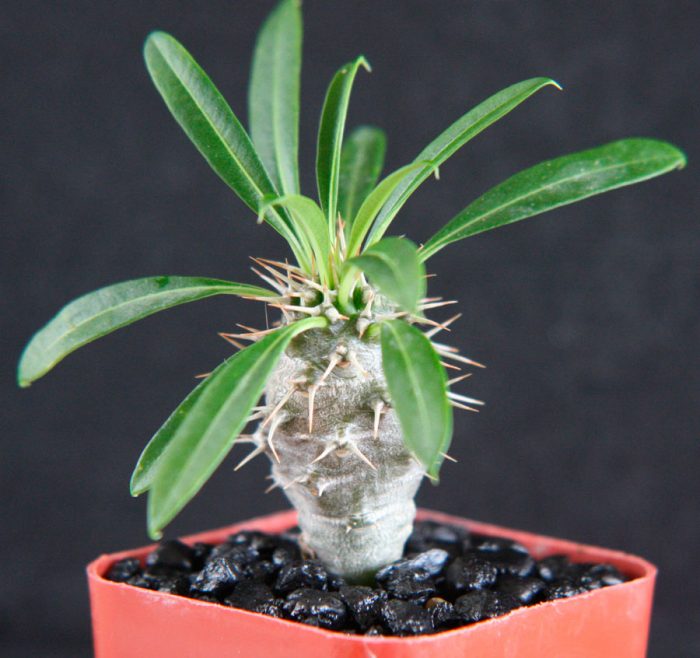
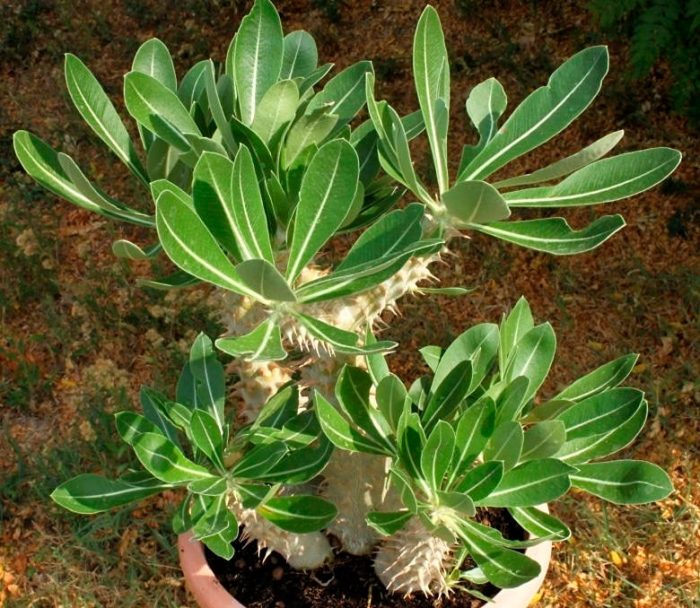
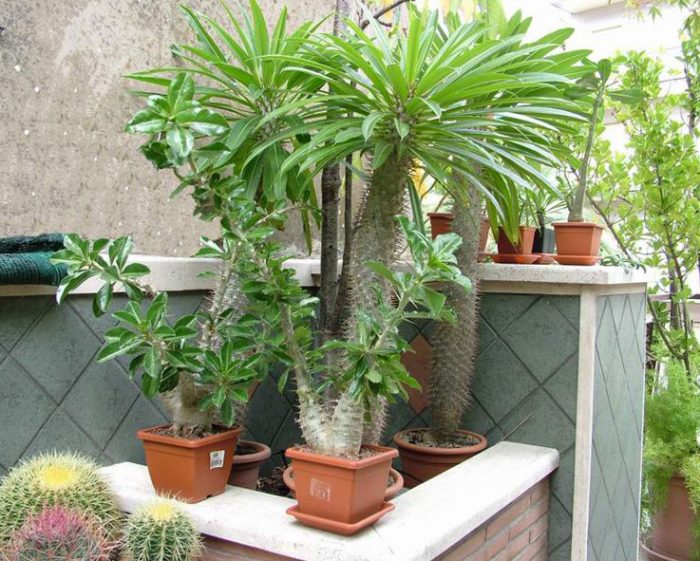
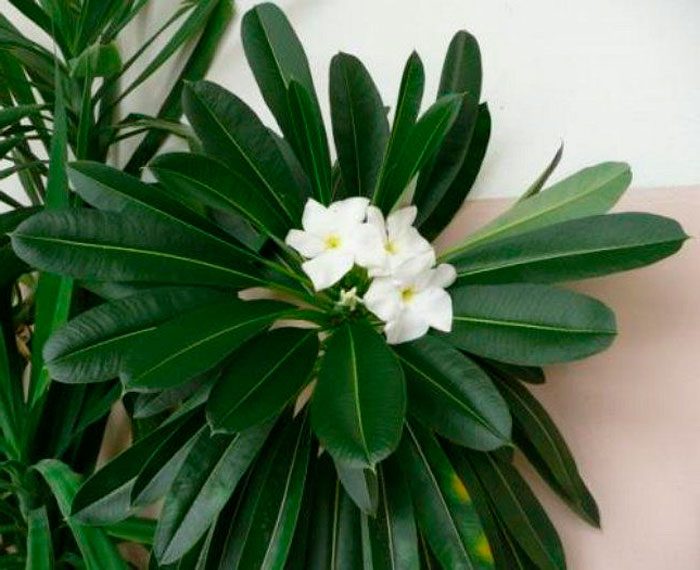
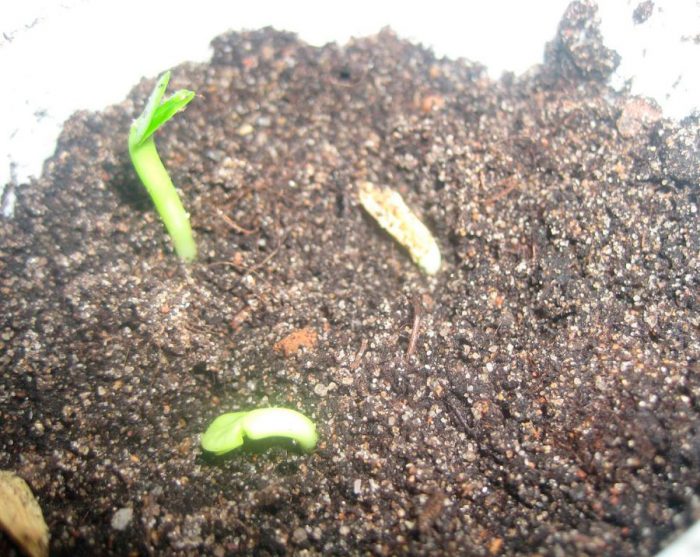
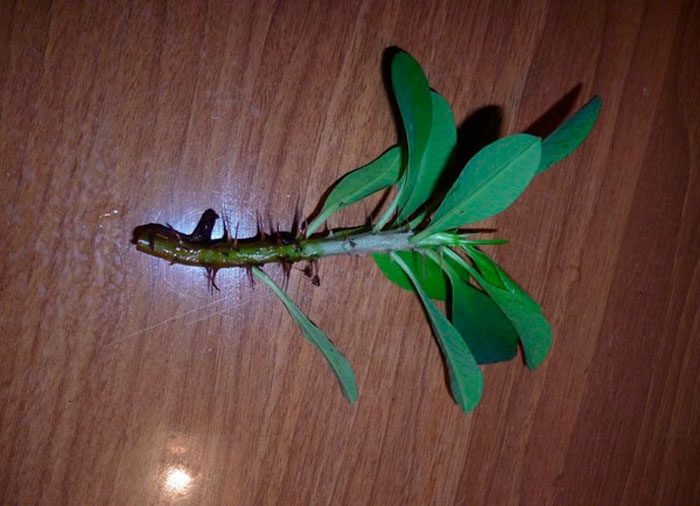
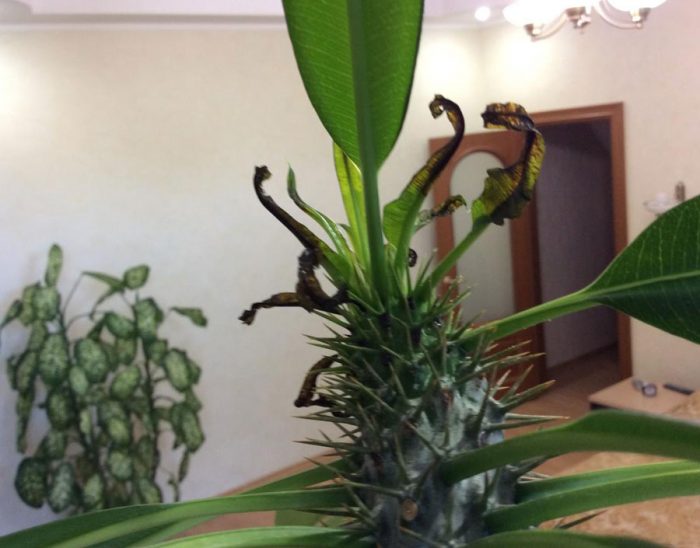
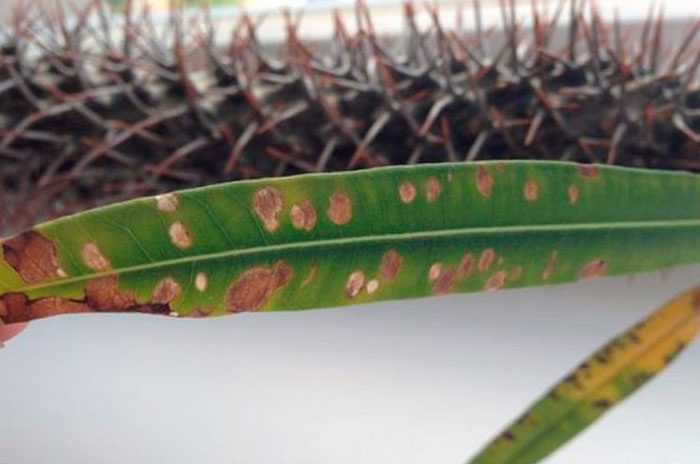
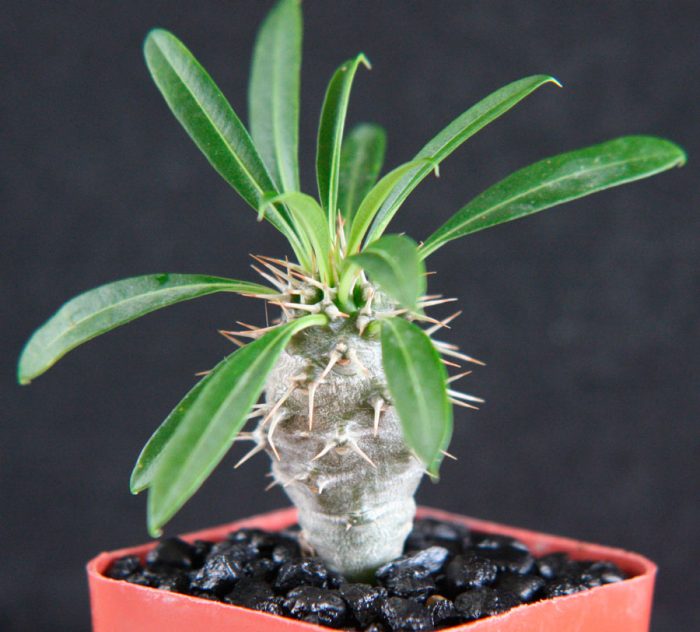
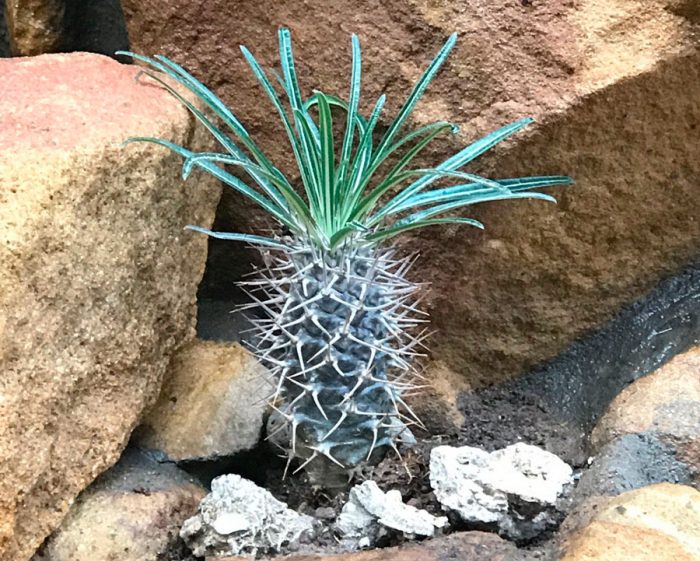
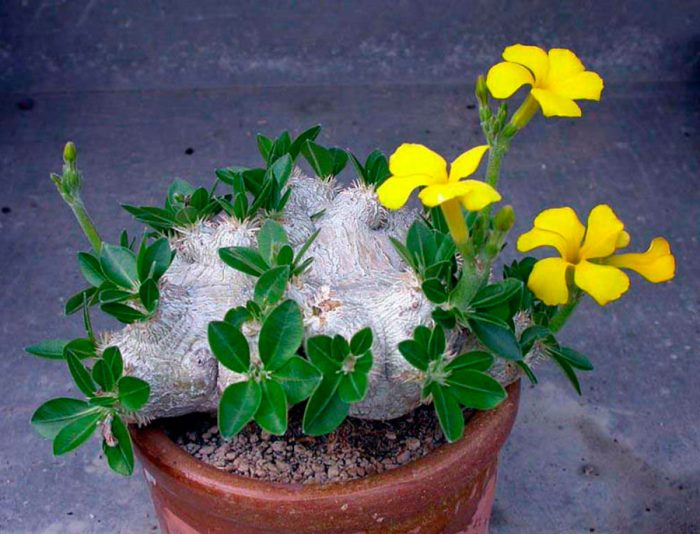
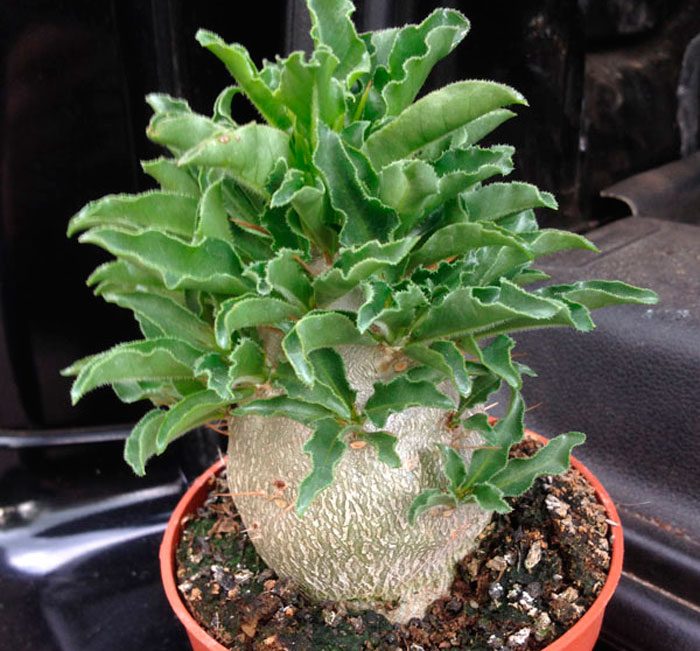
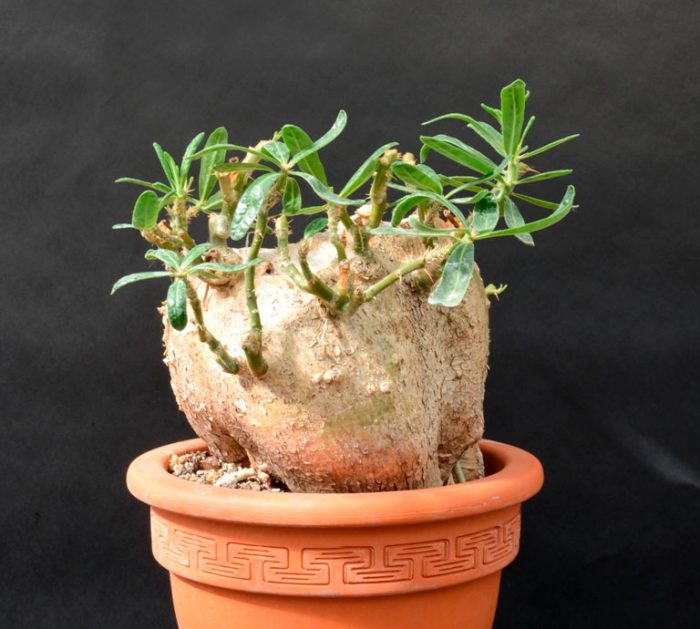
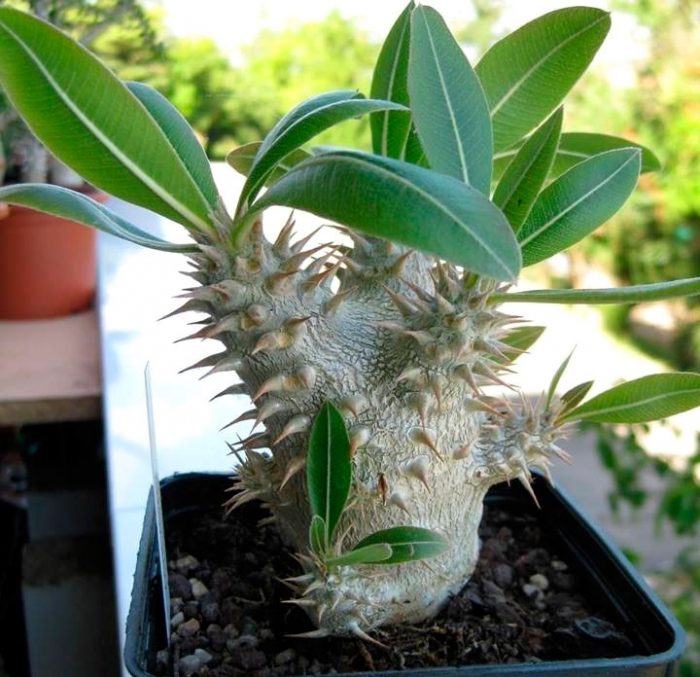
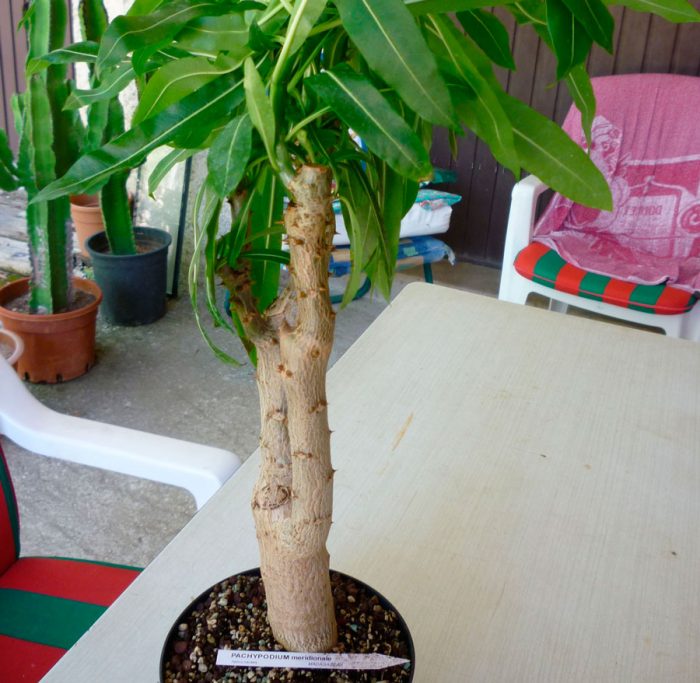
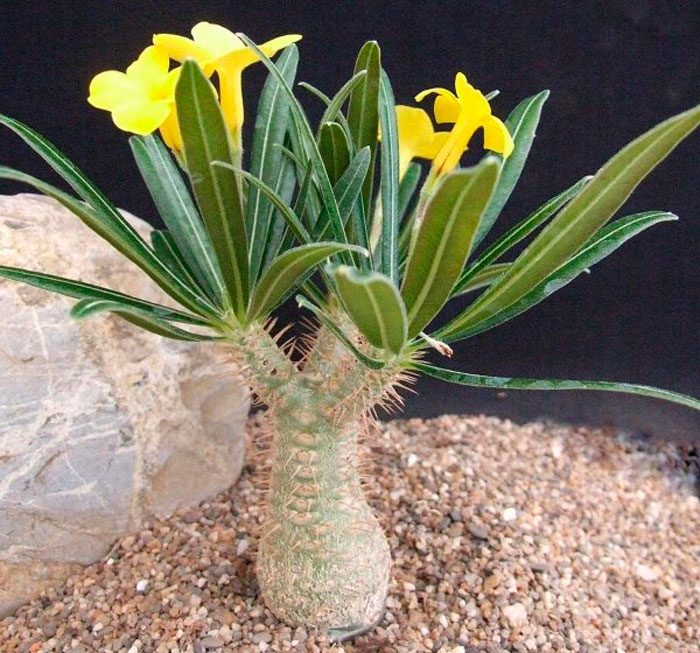
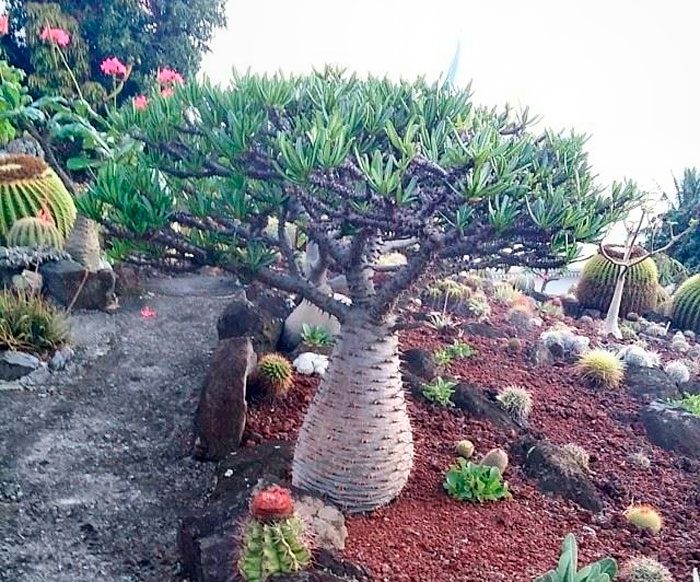
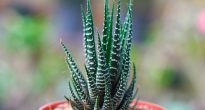



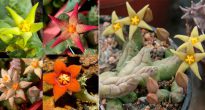


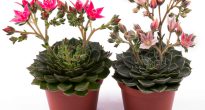


And I have a pohipodium that has grown ... somewhere around 1,500 m, and everything is growing. What should I do?
I won't brag, my dear ... What I am rich, so I am glad. My "crested hedgehog" has a height of about 30 cm, spines of 1.5-2 cm each and a dozen "children"
The photo is not attached, unfortunately - you would have looked. And so - what will you check? I don't give my personal e-mail to anyone, but there is nothing to check this official one.